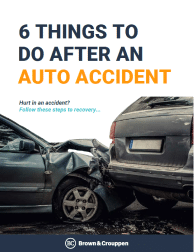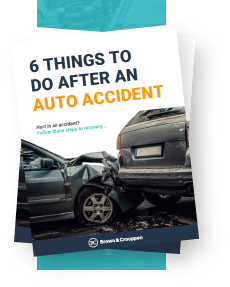Home Practice Areas
Auto Accidents
Truck Accident Lawyers
Truck Accident Lawyers
Often, truck accidents lead to serious injuries and are due to distracted driving and truck driver fatigue. The sheer size of big rigs makes them particularly dangerous in a truck crash. If you or a loved one has been injured in a semi or truck accident, request a free case evaluation from a lawyer at Brown & Crouppen Law Firm. Our truck accident lawyers are dedicated to helping those who were injured by truck drivers. Often, these accidents lead to serious injuries due to distracted driving and truck driver fatigue. Our attorneys help victims fight against trucking companies to help you receive the compensation you deserve.
Since 1979, we’ve provided legal representation for those who have suffered injuries as a result of trucking accidents (including semis and commercial trucks), and have helped our clients recover over $1 Billion in compensation. Our law firm operates on a contingency-basis, meaning that we don’t get paid unless you get paid. Request a free case evaluation by phone, chat, or tell us about your case online. And remember, our truck accident lawyers work on a contingency fee basis – we only get paid if you win.


Use our legal checklist to learn what to do after an accident and understand key legal considerations for recovering financial compensation.
Our Truck Accident Attorneys Get Results For Clients
Truck companies don’t want you to know that commercial insurance policies typically have limits between $750,000 and $1,000,000. Further, more than one insurance policy may cover the truck, the driver, and the cargo. Our attorneys help individuals get the compensation they deserve.
$6,000,000
Box Truck Accident
$390,000
Tractor Trailer
$250,000
Tractor Trailer
Many of our highly experienced personal injury attorneys started their careers working on behalf of trucking companies. They understand how the system works and how truck accident claims are processed. They know how trucking companies and their insurance providers give low initial settlement offers, and they know where to look for additional insurance coverage that can provide compensation for your medical bills and other expenses.
At the law firm of Brown & Crouppen, our truck accident attorneys work hard to take care of you, make the legal process easy, and ultimately get results.
Request a Free Truck Accident Case Evaluation From Brown & Crouppen Law Firm
Our truck accident law firm is one of the highest rated law firms in the Midwest. At Brown & Crouppen, all of our truck accident attorneys share the same goal – to get justice for people who have been injured. If you or a loved one has suffered injuries from a truck accident, get help from an attorney at Brown & Crouppen Law Firm.
Getting started with your truck accident case is easy. You can call us at 888-802-8156 for a free consultation, or tell us about your case with our free case evaluation form. And remember, there’s no upfront cost to you — if you don’t get paid, we don’t get paid. Our truck accident attorney serve locations throughout the Midwest, including the following:
At Brown & Crouppen, our lawyers provide legal representation for all truck accident cases including commercial trucks, semis, and 18-wheeler accidents. Call our law firm to tell us about the accident and find out if you have a case.
FREE CASE EVALUATION
Frequently Asked Questions (FAQs)
Who can be held liable for commercial trucking accidents?
If you or a loved one has been injured in a collision with a commercial truck, there may be several parties that could be held liable for the damages. An experienced personal injury attorney knows how to investigate the relationship between the driver and the trucking company, whether the tractor and the trailer are owned/controlled by separate entities, and investigate other potential parties.
How much is my commercial truck accident case worth?
In fact, the average settlement amount for truck accidents is over $40,000, but varies based on many case factors. More damages to the body (i.e., a broken neck versus a broken toe) equals more money damages, as you will require more care and modifications to your life as a result of your injury. There isn’t any set guideline for how much a truck accident is worth, but a personal injury attorney experienced in trucking collisions will be able to provide guidance on how much is just compensation.
How long do I have to file a truck accident lawsuit?
The statute of limitations for filing against a commercial truck driver is dependent on what kind of claim you are filing and where you are filing your claim. For example, if you are filing a personal injury claim in Missouri against a truck driver, you currently have 5 years to file your claim. However, you have two years to file in Illinois. Because over the road truck drivers are often driving in states where they do not live or states where their employer isn’t domiciled, then there may be issues concerning where the case belongs (i.e., in state court versus federal court). An experienced personal injury attorney can evaluate the facts and provide guidance on where the case needs to be filed and what’s the appropriate statute of limitations.
How long will my truck accident case take?
On average, most truck accident cases settle between 6 and 16 months from the date of the accident. However, there are many factors that can affect how long a truck accident case takes to settle (such as commercial litigation and the number of parties involved in the claim).
What should I do after a semi-truck accident?
Seek treatment immediately. Even slow-moving semi-trucks hit with significant force behind them due to their mass. Cars are designed to absorb forces from car crashes (to a certain extent), but the human body is not. Even if you do not appear to be injured, it is possible to suffer a traumatic brain injury. Seek medical treatment and keep a friend or family member nearby for the next few days to observe changes in mood or behavior.

If you have a question that’s not found on this page, you can view the frequently truck asked questions page or call us at 888-803-1307
FREE CASE EVALUATION
Our Results
TESTIMONIALS

- Last Modified:
- May 28, 2025
SCHEDULE A FREE CONSULTATION

